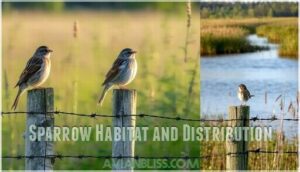This site is supported by our readers. We may earn a commission, at no cost to you, if you purchase through links.

The House Sparrow, with its chunky build and black bib, isn’t technically a true sparrow but earned its name living alongside humans for centuries.
True sparrows include Song Sparrows with their melodic calls, White-throated Sparrows sporting crisp head stripes, and Dark-eyed Juncos flashing white tail feathers.
Each species has evolved distinct markings, songs, and behaviors that make identification like solving a feathered puzzle. Once you learn their subtle differences, your backyard transforms into a living field guide.
Table Of Contents
- Key Takeaways
- Most Common Sparrow Types
- Old World Vs. New World Sparrows
- Sparrow Physical Characteristics
- Sparrow Behavior Patterns
- Sparrow’s Diet and Feeding Habits
- Sparrow Habitat and Distribution
- Frequently Asked Questions (FAQs)
- How many types of Sparrows are there?
- How to identify the four subspecies of the Fox Sparrow?
- What is a sparrow bird?
- What is the most common sparrow in the world?
- How many sparrow types are there?
- What are the 4 sexes of Sparrows?
- What is the most beautiful sparrow in the world?
- What bird looks like a sparrow but is smaller?
- What is the most common type of sparrow?
- What bird is mistaken for a sparrow?
- Conclusion
Key Takeaways
- You’ll find two main sparrow groups: Old World sparrows (like House Sparrows) that aren’t technically true sparrows, and New World sparrows from the Passerellidae family with distinct evolutionary origins.
- Common backyard species include House Sparrows with black bibs, Song Sparrows with heavy breast streaks, and Fox Sparrows with rusty coloring – each showing unique markings that make identification like solving a feathered puzzle.
- These adaptable birds display fascinating social behaviors including cooperative foraging, complex vocal communication, and safety-in-numbers flocking patterns while switching from seed-based diets to insect hunting during breeding season.
- With roughly 140 sparrow species worldwide and 37 in North America alone, you’ll discover incredible habitat diversity from urban environments to remote wilderness areas, with some species migrating thousands of miles while others stay year-round.
Most Common Sparrow Types
In your backyard, you’ll likely spot several common sparrow types that make identifying sparrows both rewarding and straightforward.
The House Sparrow, with its distinctive gray crown and black bib, thrives near human settlements and represents one of the most widespread bird species globally.
Song Sparrows showcase heavy breast streaks that form a central dark spot, plus they’re year-round residents with complex melodies.
Fox Sparrows display rufous tails and "foxy" rusty-gray coloring that makes them unmistakable during winter months.
These types of sparrows occupy different common habitats – from urban areas to brushy fields – while showing fascinating regional variations in size and coloring patterns despite declining population trends in some areas.
Some sparrows, like the White-crowned Sparrow, exhibit distinct regional dialects in their songs.
Old World Vs. New World Sparrows
When spotting sparrows in your yard, you’re actually observing two completely different bird families that evolved on opposite sides of the planet.
These feathered neighbors represent millions of years of evolution happening right outside your window.
Old World sparrows like the House Sparrow belong to family Passeridae, while New World sparrows are part of Passerellidae – their genetic ancestry tells a fascinating story of evolutionary divergence spanning millions of years.
| Feature | Old World Sparrows | New World Sparrows |
|---|---|---|
| Body Type | Stocky, robust build | Varied sizes, often slender |
| Habitat Differences | Urban-adapted, open areas | Diverse: forests to wetlands |
| Conservation Status | Some declining populations | Mixed, habitat-dependent |
As introduced species, Old World sparrows thrive in cities with their thick beaks and sturdy frames.
Some sparrows, like those with yellow head markings, are found in North America.
New World sparrows showcase incredible diversity – from desert dwellers to forest singers – each perfectly adapted to their specific environment across the Americas.
Sparrow Physical Characteristics
Sparrows share key physical traits that make sparrow identification manageable once you know what to look for.
Most species display earth-toned plumage variations in browns, grays, and tans that help them blend into their surroundings.
You’ll notice significant size differences between species – from tiny 4-inch Grasshopper Sparrows to robust 7-inch Fox Sparrows.
Beak morphology tells an important story about each bird’s lifestyle.
Their conical beaks perfectly suit seed-cracking, though some species have slightly thinner bills for insect hunting.
Bird colors range from subtle gray-brown combinations to striking black and white head stripes on White-crowned Sparrows.
Markings identification becomes easier when you focus on specific bird patterns like breast streaking, eye rings, and crown stripes.
Males typically show brighter bird anatomy features than females, while hybrid appearance occurs where different species overlap, creating fascinating intermediate forms that challenge even experienced birders.
Some sparrows, like the White-throated Sparrow, exhibit distinct crown variations.
Sparrow Behavior Patterns
The fascinating world of bird behavior reveals sparrows as incredibly social creatures with complex Social Interactions.
You’ll notice they’re rarely alone, forming tight-knit flocks that act like neighborhood watch groups.
Their Vocal Communication involves chirps, trills, and calls that serve different purposes – from warning about danger to claiming territory.
Mating Rituals include elaborate courtship displays where males puff their chests and sing their hearts out.
In the context of Predator Evasion, sparrows use the "safety in numbers" approach, with scouts alerting the group to threats.
Their Foraging Strategies involve cooperative searching, where one bird’s discovery becomes everyone’s feast.
These bird behavior patterns make sparrows masters of survival through teamwork and constant chatter.
Sparrows also display mobbing behavior patterns to ward off predators.
Sparrow’s Diet and Feeding Habits
Your backyard sparrows have feeding habits that’ll surprise you with their adaptability. These little seed-crackers use their cone-shaped beaks to tackle everything from sunflower seeds to tiny millet.
During spring, they switch gears and hunt insects to fuel their growing chicks. You’ll notice their foraging techniques involve group dining – they scratch through leaf litter together, keeping watch while others eat.
Additionally, their behavior reflects various feeding behavior types.
Here’s what makes sparrow diets fascinating:
- Seed preferences change with seasons – they love nyjer in winter, grass seeds in summer
- Insect consumption spikes to 50% during breeding season for protein power
- Urban diets include breadcrumbs and pizza crusts (though seeds stay healthier)
- Seasonal changes mean berries become autumn favorites
- Bird feeding stations make them loyal backyard visitors who remember good spots
Sparrow Habitat and Distribution
Understanding where you’ll find different sparrows feels like solving a backyard puzzle. These remarkable bird species have mastered the art of calling diverse habitats home, from your suburban garden to remote wilderness areas. Sparrows showcase incredible Habitat Diversity, with each species carving out its perfect niche in nature’s grand design.
Regional Variations shape where you’ll spot these feathered friends:
- House sparrows dominate urban landscapes and farmlands across most continents
- White-crowned sparrows prefer open grasslands, tundras, and brushy areas
- Song sparrows thrive near water sources like marshes, streams, and wetlands
Migration Patterns reveal fascinating journeys – some species travel thousands of miles seasonally while others stay put year-round. Introduced Species like house sparrows have spread globally, adapting remarkably well to human-modified environments. Their global success is partly due to their adaptability to landscapes, allowing them to thrive in close proximity to humans.
Understanding bird species distribution and Conservation Status helps you appreciate these adaptable survivors in your local bird habitats.
Frequently Asked Questions (FAQs)
How many types of Sparrows are there?
Picture countless tiny brown birds flitting through your backyard like scattered leaves.
You’ll discover there are roughly 140 sparrow species worldwide, with about 37 calling North America home, each perfectly adapted to their unique environments.
How to identify the four subspecies of the Fox Sparrow?
You’ll spot four Fox Sparrow groups by their colors: "Red" foxes have rusty tones, "Sooty" ones are dark gray-brown, "Slate-colored" show gray heads with brown backs, and "Thick-billed" display large beaks with muted tones.
The key characteristic to identify these groups is their distinct colors.
What is a sparrow bird?
You might think sparrows are just "little brown birds," but they’re actually fascinating songbirds with conical beaks perfect for cracking seeds.
These adaptable creatures thrive everywhere from bustling cities to quiet meadows, bringing joy through their cheerful songs.
What is the most common sparrow in the world?
You’ll find the House Sparrow everywhere humans live.
With over one billion individuals worldwide, they’re Earth’s most abundant sparrow species.
These adaptable birds thrive in cities, farms, and suburbs across every continent except Antarctica, making them a highly adaptable species.
How many sparrow types are there?
You’ll discover around 140 sparrow species worldwide, split between Old World and New World families.
North America alone hosts 37 types, from common House Sparrows to rare regional varieties like Baird’s and Bachman’s Sparrows.
What are the 4 sexes of Sparrows?
Sparrows don’t actually have four sexes – you’ll only see males and females in these birds.
However, some species like White-throated Sparrows show two distinct color morphs within each sex, creating fascinating behavioral differences.
What is the most beautiful sparrow in the world?
Like a living jewel in nature’s crown, you’ll find the Fox Sparrow takes the beauty prize.
Its rich rufous tones, gray head, and reddish tail create stunning contrast that’ll make you stop and stare in wonder at its rich rufous tones.
What bird looks like a sparrow but is smaller?
You’ll likely spot wrens, which resemble sparrows but are noticeably smaller and more compact.
These tiny brown birds have upturned tails and bold personalities, often darting through bushes while delivering surprisingly loud, cheerful songs.
What is the most common type of sparrow?
You’ll find the House Sparrow everywhere around human settlements. This adaptable little bird claims the title as the world’s most widespread sparrow species, with over one billion individuals thriving globally.
What bird is mistaken for a sparrow?
You’ll often confuse finches, wrens, and juvenile cardinals with sparrows since they share similar brownish plumage and small size.
Dark-eyed juncos are frequent sparrow imposters with their grayish coloring and ground-feeding habits that’ll fool you, making them imposters.
Conclusion
Contrary to popular belief, most backyard "sparrows" aren’t actually true sparrows at all.
Now you’ve discovered the fascinating world of these diverse songbirds, from chunky House Sparrows to melodic Song Sparrows.
Understanding different types of sparrows transforms ordinary birdwatching into detective work. You’ll notice their unique markings, hear distinct calls, and appreciate their specialized behaviors.
Grab your binoculars and start identifying—your backyard holds more feathered mysteries than you ever imagined. Happy birding adventures await!







